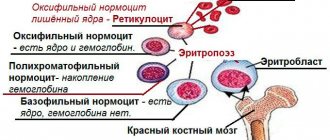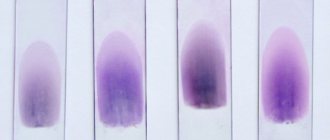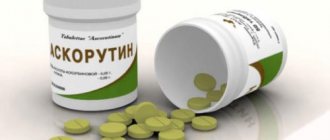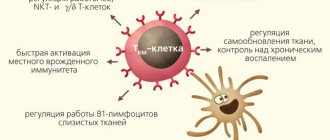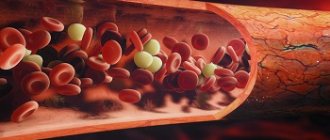Detailed description of the study
The study is important to study the distribution, volume and type of fats. Very low and low density lipoproteins (LP) belong to the atherogenic fraction, and high density lipoproteins help prevent atherosclerotic changes in blood vessels.
Atherogenicity index – the ratio of low- and high-density drugs. This indicator determines the risk of developing atherosclerosis and coronary heart disease. Triglycerides are lipids that are significant for the diagnosis of lipid metabolism disorders - hyperlipidemias, which are divided into five types and differ in origin, pathogenesis and therapy used.
Determining the level of various cholesterol fractions plays an important role in diagnosing cardiovascular pathologies, determining patient management tactics, predicting the development of complications, and monitoring treatment.
Lipidogram
Interpretation of the results of the Lipidogram study
Interpretation of test results is for informational purposes only, is not a diagnosis and does not replace medical advice.
Reference values may differ from those indicated depending on the equipment used, the actual values will be indicated on the results form. Currently, the prognostic significance of the concentration of total cholesterol in the blood is undoubted in relation to the risk of mortality from major diseases associated with atherosclerosis (coronary artery disease and cerebral strokes). When the cholesterol level in the blood is below 5.2 mmol/l, the risk of developing atherosclerosis is the lowest. If the concentration of LDL cholesterol in the blood is below 2.59 mmol/l, atherosclerotic changes in the coronary arteries rarely occur.
An increase in LDL cholesterol above 2.59 mmol/l is observed when eating foods rich in animal fats and cholesterol. Physical inactivity, unbalanced nutrition, resulting excess body weight, smoking, arterial hypertension, diabetes mellitus are factors that increase the risk of coronary artery disease. The presence of at least two of the above factors accelerates the development of critical coronary atherosclerosis by approximately 10 years.
Reducing the concentration of total cholesterol in the blood and increasing HDL cholesterol reduces the progression of atherosclerosis. A 10% reduction in total cholesterol levels in the blood leads to a 20% reduction in mortality from heart disease. An increase in HDL cholesterol concentration by 0.03 mmol/l reduces the risk of coronary disease by 2-3% in men and women. In addition, regardless of the content of total cholesterol in the blood (including those exceeding 5.2 mmol/l), an inverse relationship remains between the content of HDL cholesterol and the incidence of cardiac pathology.
Concentrations of HDL cholesterol less than 1.3 mmol/l and triglycerides in the blood more than 2.3 mmol/l are independent prognostic indicators of the likelihood of death from coronary artery disease. Therefore, HDL cholesterol levels should be considered a more accurate predictor of mortality from coronary artery disease than total cholesterol concentrations.
Based on the above, the following aspects should be taken into account in clinical practice:
- Reducing the concentration of LDL cholesterol and increasing the concentration of HDL cholesterol helps reduce the risk of developing atherosclerosis.
- The level of testosterone in men and estrogen in women is directly related to lipid metabolism disorders.
- The concentration of Lp(a) in the blood serum reflects the activity of the atherosclerotic process.
- Low physical activity (physical inactivity), excess nutrition, and smoking have an adverse effect on lipid metabolism.
- Correction of lipid disorders should be aimed not only at reducing blood cholesterol levels, but also at normalizing the lipid profile.
- Exercise and weight loss reduce plasma LDL-cholesterol and triglyceride concentrations and increase plasma HDL-cholesterol concentrations.
- A healthy lifestyle will prevent the development of atherosclerosis, the foundations of which can form at a relatively young age.
Optimal lipid profile (lipid profile):
- Total cholesterol
- HDL cholesterol > 1.3 mmol/l.
- LDL cholesterol
- Triglycerides
- CA
- AIP
A study of lipid metabolism (lipidogram) should be carried out in individuals in the age range from 20 to 80, every 5 years. It must be remembered that the likelihood of developing IHD and cardiovascular diseases increases if the subjects have other risk factors (smoking, diabetes mellitus, arterial hypertension, family history of IHD in first-degree relatives that developed in men under the age of 55 years, in women under 65 years of age). Therefore, to successfully reduce mortality from cardiovascular diseases, this population must be tested for the presence of all these factors.
References
- ESC/EOA Clinical Guidelines for the Diagnosis and Treatment of Dyslipidaemias, 2021.
- Russian recommendations VI revision. Diagnosis and correction of lipid metabolism disorders for the prevention and treatment of atherosclerosis, 2021.
- NCEP Expert Panel on detection, evaluation and treatment of high blood cholesterol in adults. Executive summary of the third report of the National Cholesterol Education Program (NCEP) Expert Panel on detection, evaluation and treatment of high blood cholesterol in adults (Adult Treatment Panel III). JAMA 2001;285:2486–2497.
Lipidogram (triglycerides, cholesterol, HDL, LDL, atherogenicity coefficient)
A lipidogram is a comprehensive study that allows you to determine the amount of lipids of various fractions and their ratio in the blood serum. The study determines the distribution, type and volume of fats. The main goal of the study is to identify pathologies of lipid metabolism, assess the likelihood of development and predict the course of diseases of the cardiovascular system. This test can also be used to diagnose pathologies of the liver, kidneys, pancreas, brain, monitor the effectiveness of treatment and the recommended diet.
The complex includes the definition:
- triglyceride content (in the “Price” section on the official website of medical item 612);
- total cholesterol (cholesterol) level (item 615);
- high density lipoprotein (HDL) cholesterol content (item 611);
- low-density lipoprotein (LDL) cholesterol content (item 613);
- atherogenic coefficient.
Triglycerides
Triglycerides are the main blood lipids. One source of triglycerides is the food we eat. They are also produced by fat cells, liver cells and intestinal cells. Blood does not contain this type of lipid in a free state, but only in combination with proteins, in the form of macromolecules called lipoproteins. The main transporters of triglycerides in the bloodstream are very low-density lipoproteins (VLDL).
Triglycerides are the main lipids found in body fat and in food. One molecule consists of triatomic glycerol and three residues of higher fatty acids (mainly palmitic, stearic, oleic and linoleic acids). The initial accumulation of triglycerides occurs in fat cells. Then a process of hydrolysis occurs, the result of which is their breakdown into glycerol and fatty acids and release into the circulation system. The main task of triglycerides is to provide cells with energy.
An increase in triglyceride levels causes changes in other lipid profile parameters and is associated with pathologies such as diabetes mellitus, hypertension, and obesity. Also, excess triglyceride levels are an indicator of a high risk of developing atherosclerosis, cerebrovascular disease, and coronary heart disease.
Cholesterol (cholesterol)
Cholesterol (cholesterol) is a fat-like organic compound, a lipophilic (fatty) alcohol found in the membranes of human and animal cells. Its amount in the blood serum characterizes the quality of lipid metabolism and reflects the likelihood of developing cardiovascular diseases and the complications they can cause.
Replenishment of cholesterol occurs both directly in the body (it is produced by the liver, intestines, gonads, kidneys and adrenal glands (about 80%)) and with food products of animal origin (most of all it is found in meat, butter, eggs). Cholesterol does not dissolve in water. Its transporter is lipoprotein complexes.
Lipoprotein cholesterol is divided into several fractions: HDL - high-density lipoproteins, LDL - low-density lipoproteins; VLDL – very low density and others. They have different compositions and perform different tasks. Total cholesterol combines three types:
- cholesterol, which is part of circulating lipoproteins;
- cholesterol, which is combined with fatty acids (esterified);
- free cholesterol.
Age has a significant impact on the amount of cholesterol in the blood. In infants, the concentration does not exceed 3 mmol/l. As a person grows older, gender differences begin to affect themselves. For men, cholesterol levels rise until old age, and then it decreases. In women, the dynamics are slower until menopause, and then cholesterol levels can exceed those of men. The dynamics of the process are influenced by hormones that can increase (androgens) or decrease (estrogens) the concentration of total cholesterol in the blood.
Total cholesterol levels are examined to determine the likelihood of atherosclerosis and to determine any abnormalities in lipid metabolism. Elevated cholesterol levels provoke the development of atherosclerosis of blood vessels and cardiac ischemia. Based on data on cholesterol levels, and taking into account existing diseases, age, gender, blood pressure, smoking habits, an individual forecast is made about the degree of possibility of developing complications caused by atherosclerosis (heart attack, stroke).
Cholesterol levels are reduced through diet - the effect can be 10-15%. The level of total cholesterol that must be maintained to minimize the possibility of cardiovascular disease should not exceed 5.2 mmol/L. During treatment, special attention is paid to reducing LDL cholesterol levels.
HDL cholesterol
High-density lipoproteins (HDL) differ from other lipid fractions in their low cholesterol content and the ability to transfer it from the cells of the heart vessels, cerebral arteries, and other peripheral organs to the liver, where it is converted into bile acids, utilized and excreted from the body.
Due to its antiatherogenic effect (i.e., action that reduces the likelihood of developing atherosclerosis), high-density lipoproteins are the only fraction that prevents the formation of atherosclerotic plaques in blood vessels, thereby preventing the development of cardiovascular diseases (therefore, HDL has another name - “good "cholesterol).
A high level of HDL cholesterol is a favorable indicator that reduces the risk of heart and vascular pathologies. When its level is low, there is a high probability of early development of atherosclerosis and cardiovascular diseases, often combined with metabolic disorders, which can manifest as high levels of triglycerides, insulin, and type 2 diabetes in the blood. Men have lower average HDL levels than women.
LDL cholesterol
Low-density lipoproteins (LDL) belong to beta lipoproteins and are the main carriers of cholesterol, transporting it in the form of esters. Research results have convincingly proven that the risk of developing atherosclerosis and, as a consequence, diseases of the cardiovascular system is significantly higher with elevated HDL cholesterol than with total cholesterol. This fact is explained by the fact that it is low-density lipoproteins that are the main transporters of cholesterol, both from food and produced by the liver, to the cells of tissues and organs. In people with a hereditary predisposition to high cholesterol or in those who abuse fatty meat and dairy products, LDL cholesterol accumulates on the inner surface of the walls of blood vessels, which contributes to the formation of atheroclerotic plaques, narrowing their lumen and causing the formation of blood clots. In light of the above, LDL cholesterol testing has important diagnostic value not only in determining the likelihood of developing atherosclerosis and subsequent complications, but also in monitoring the effectiveness of cholesterol-lowering drugs.
A decrease in the level of total cholesterol, increased due to the LDL fraction (this is reflected by an increase in the calculated value - the atherogenic coefficient), can be achieved by prescribing a diet and lipid-lowering therapy.
Atherogenic coefficient
To determine the likelihood of developing atherosclerosis, coronary heart disease and other pathologies of the heart and blood vessels, knowing only the total level of cholesterol in the blood is not enough. Adequate diagnosis can be carried out only on the basis of determining the ratio of lipid fractions and identifying the predominant one. The atherogenicity coefficient is a reliable indicator of the degree of lipid metabolism disorder and the risk of developing atherosclerosis. It is equal to the ratio of the difference between total cholesterol and HDL cholesterol to total high-density lipoprotein cholesterol:
KA = (total cholesterol - HDL cholesterol)/HDL
If the coefficient is higher than normal, then there is a high probability of developing cardiovascular pathologies.
A comprehensive study of lipid fractions (lipidogram) is recommended for everyone starting from the age of 20 every five years. If family members had a history of high cholesterol or heart disease at a young age, it is recommended that their children first take a cholesterol test between the ages of 2 and 10 years.
How is the analysis done?
Taking a lipid profile is quite easy. The last meal should be eaten 8 hours before the test. Blood is drawn from a vein on an empty stomach. This procedure must be done in the morning before 11 o’clock. To obtain more accurate results, it is recommended to give up alcohol and cigarettes for 3-4 days. Also, contact your healthcare provider a few days in advance. You may need to eliminate certain medications that may interfere with your results. Before entering the laboratory, be sure to relax and not worry.
Results can be obtained within 1-2 days. You definitely need to come to a specialist with them and not try to figure them out on your own.
Decoding the results
Reference values are 0.26-1.04 mmol/l. An increase in indicators indicates a violation of lipid metabolism. The reason for this may be either a hereditary predisposition or poor nutrition (excess fat in the daily diet). If violations are detected, therapy or preventive measures are prescribed. Laboratory values are monitored at regular intervals until they return to normal. For patients with kidney pathologies and diabetes, increased levels pose a particularly high danger. A high level of VLDL in the presence of such pathologies leads to the rapid development of atherosclerosis.
It is necessary to take into account that blood is donated for research when a person is practically healthy. After an acute illness or surgery, at least 1.5 months must pass.
Who needs to get tested?
It is recommended to do a lipid blood test, the price of which in our clinic is quite adequate:
- healthy people when undergoing a full examination (after 20 years). This applies to men and women;
- children in transition (9-11 years old). It must be taken once to monitor the absence of pathologies;
- for obesity or anorexia nervosa;
- with alcohol poisoning;
- for diabetes and gout.
In any case, a specialist will send you for a lipid factor test. Be sure to follow all doctor's recommendations.
What to do if the indicators are not normal?
The key characteristic of a lipid profile is lipids. Their deviations from the norm indicate that the patient does not lead a healthy lifestyle. Therefore, to normalize the functioning of the body, first of all, it is worth giving up bad habits. This is especially true for smoking and alcohol. Next, eliminate foods high in trans fats from your diet and be sure to undergo a full examination of your cardiovascular system. Your doctor will tell you more details during your consultation. He will outline the treatment plan, dosage of medications and the rehabilitation process.
Lipid metabolism analysis
A blood test for cholesterol and its fractions is called a lipidogram (lipid profile). This analysis is mandatory for every person - it helps to assess the risks of developing cardiovascular diseases.
A typical lipid profile looks for the following levels:
total cholesterol (TC); high density lipoprotein cholesterol (HDL); low-density lipoprotein cholesterol (LDL); triglycerides (TG).
The patient may be assigned a detailed lipid profile. This is done in this case if one or more people in a person’s family suffer from hypercholesterolemia.
There are certain limits for lipid profile indicators for healthy people who do not suffer from cardiovascular pathologies. They are:
TC – less than 5 mmol/l (<200 mg/dl); LDL – less than 3 mmol/l (<115 mg/dl); HDL – in men above 1 mmol/l (>40 mg/dl), in women above 1.2 mmol/l (>45 mg/dl); TG – below 1.7 mmol/l (<150 mg/dl)
For those patients who suffer from angina, diabetes or atherosclerosis, have had a stroke, heart attack or serious surgical interventions in the cardiovascular system, normal cholesterol levels will be completely different.
Reference values (Deciphering lipid metabolism analysis)
| Index | Normal values | ||
| Total cholesterol (TC) | Age < 5 years 5–10 years 10–15 years 15–18 years | Men 2.95–5.25 3.13–5.25 3.08–5.23 2.93–5.10 | Women 2.90–5.18 2.26–5.30 3.21–5.20 3.08–5.18 |
| Triglycerides (TG) | Age < 10 years 10–15 years 15–18 years | Men 0.34–1.13 0.36–1.41 0.45–1.81 | Women 0.40–1.24 0.42–1.48 0.40–1.53 |
| High-density lipoproteins (HDL, HDL-C) | Age 5–10 years 10–15 years 15–18 years | Men 0.98–1.94 0.96–1.91 0.78–1.63 | Women 0.93–1.89 0.96–1.81 0.91–1.91 |
| Low-density lipoproteins (LDL, LDL-C) |
| ||
| Age 5–10 years 10–15 years 15–18 years | Men 1.63–3.34 1.66–3.44 1.61–3.37 | Women 1.76–3.63 1.76–3.52 1.53–3.55 | |
| Very low density lipoproteins (VLDL, VLDL-C) | <0.8 mmol/l | ||
| Non-high-density lipoprotein (non-HDL) cholesterol | desired level < 3.8 mmol/l | ||
For people over 18 years of age, normal cholesterol levels are less than 5.0 mmol/L. However, this number is arbitrary, since the doctor must take into account other indicators of the lipid spectrum (LDL and triglyceride levels will be important).
Get tests done at East Clinic:
| Lipid metabolism. Genetic predisposition to dyslipidemia and the development of atherosclerosis. Study of polymorphisms in genes: APOE (C112R T>C), APOE (R158C C>T), APOB (R3527Q G>A), APOB (G>A), PCSK9 (T>C), ABCA1 (R219K G>A) , APOC3 (-455 C>T), APOC3 (-482 C>T), APOC3 (G>C), LPL (N318S A>G), LPL (S447X C>G), PON1 (L55M A>T), PON1 (Q192R A>G). |

